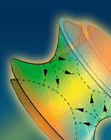

![]()
![]()
![]()
![]()
![]()
![]()
![]()
|
A close-up of the quadrupole ion trap used by the author to observe resonance in mercury ions around 1971
|
By F. G. Major Throughout history, a measure of the level of technological development of a society has been the precision of the clocks it was able to build. In our time the astonishingly accurate Global Positioning System for example, allowing pin-point precision in positioning instantaneously over the entire globe, is possible because of the development of quantum-based atomic clocks. This book offers a broad understanding of the physical principles underlying and unifying the description of clocks based on the oscillatory behavior of physical systems as they evolved from early mechanical clocks to the present day quantum-based atomic clocks. It is written for the serious non-specialist with some physics or engineering background; the quantum aspects are dealt with in a self-contained broad manner with a minimum of mathematical symbolism. The selection and organization of material, far from being narrowly formal, range over diverse salient topics touching on many facets of time and time-keeping, including:
The emphasis, however, is on the microwave and optical atomic frequency/time standards:
|
